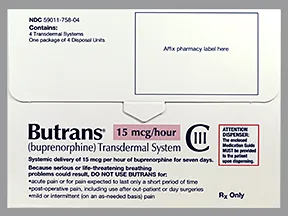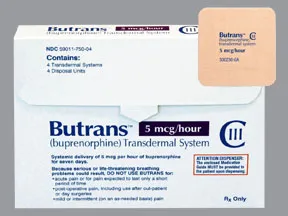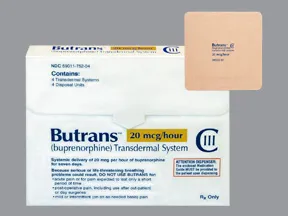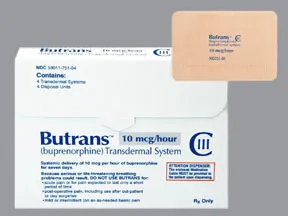Uses
This medication is used to help relieve severe ongoing pain (such as due to arthritis, chronic back pain). Buprenorphine belongs to a class of drugs known as opioid analgesics. It works in the brain to change how your body feels and responds to pain.The higher strengths of this drug (7.5, 10, 15, or 20 micrograms per hour patches) should be used only if you have been regularly taking moderate amounts of opioid pain medication. These strengths may cause overdose (even death) if used by a person who has not been regularly taking opioids.Do not use this medication to relieve pain that is mild or that will go away in a few days. This medication is not for occasional ("as needed") use.
How to use Butrans Patch, Transdermal Weekly
See also Warning section.
Read the Medication Guide and, if available, the Patient Information Leaflet provided by your pharmacist before you start using this medication and each time you get a refill. Learn how to properly use, store, and discard the patches. If you have any questions, ask your doctor or pharmacist.
Use this medication on a regular schedule as directed by your doctor, not as needed for sudden (breakthrough) pain. If you are already using an opioid medication, ask your doctor or pharmacist if you should stop or change how you use your other opioid medication. It may take 24 hours or longer before you have pain relief from buprenorphine patches. Other pain relievers (such as acetaminophen, ibuprofen) may also be prescribed. Ask your doctor or pharmacist about using buprenorphine safely with other drugs.
Apply this medication to the skin as directed by your doctor. Do not apply on burns, cuts, irritated skin, or skin that has been exposed to radiation (x-ray treatment). Select a dry, non-hairy area on a flat part of your body, such as the upper chest, sides of the chest, upper back, or upper outer arms. In people unable to think clearly (such as due to dementia), apply the patch on the upper back to lessen the chance it might be removed or placed in the mouth. If there is hair on the skin, use scissors to clip the hair as close as possible to the skin. Do not shave hair since this might cause skin irritation. If needed, use water to clean the area. Do not use soap, oils, lotions, or alcohol on the application site. Dry the skin well before applying the patch.
The patch is usually changed every 7 days. To avoid irritation, apply to a different area each time and do not apply to the same site within 3 weeks. Be sure to remove the old patch before applying a new patch. The used patch should be folded in half with the sticky sides together and properly discarded. If your manufacturer has supplied a patch disposal unit, follow directions for its use.
Do not use the patch if it appears to be broken, cut, or damaged. Remove from the sealed pouch, peel off the protective liner, and apply right away to the skin. Press firmly in place with the palm of the hand for about 15 to 30 seconds, making sure the contact is complete (especially around the edges). If your prescribed dose is for more than one patch, apply them right next to each other but make sure the edges of the patches do not touch or overlap. After applying the patch, wash your hands with water only.
You may bathe, shower, or swim while wearing the patch. If you have problems with the patch not sticking at the application site, you may tape the edges in place with certain kinds of first aid tape. Ask your doctor or pharmacist about which type of tape should be used. If this problem lasts, ask your doctor for advice. If the patch falls off before 7 days, a new patch may be applied to a different skin site. Be sure to let your doctor know if this happens.
If you accidentally touch the sticky layer to your skin or handle a cut or damaged patch, wash the area well with clear water. If the patch comes off and accidentally sticks to the skin of another person, immediately remove the patch, wash the area with water, and get medical help for them right away. Do not use soap, alcohol, or other products to wash the area.
The dosage is based on your medical condition and response to treatment. Do not apply more patches than directed, change them more often, or use them for a longer time than prescribed. Your risk for side effects will increase.
Suddenly stopping this medication may cause withdrawal, especially if you have used it for a long time or in high doses. To prevent withdrawal, your doctor may lower your dose slowly. Tell your doctor or pharmacist right away if you have any withdrawal symptoms such as restlessness, mental/mood changes (including anxiety, trouble sleeping, thoughts of suicide), watering eyes, runny nose, nausea, diarrhea, sweating, muscle aches, or sudden changes in behavior.
When this medication is used for a long time, it may not work as well. Talk with your doctor if this medication stops working well.
Though it helps many people, this medication may sometimes cause addiction. This risk may be higher if you have a substance use disorder (such as overuse of or addiction to drugs/alcohol). Use this medication exactly as prescribed to lower the risk of addiction. Ask your doctor or pharmacist for more details.
Tell your doctor if your pain does not get better or if it gets worse, or if you have any new pain.
Side Effects
See also Warning section.
Nausea, vomiting, constipation, lightheadedness, dizziness, drowsiness, dry mouth, or headache may occur. Irritation, itching, or redness at the application site may also occur. Some of these side effects may decrease after you have been using this medication for a while. If any of these effects last or get worse, tell your doctor or pharmacist promptly.
To prevent constipation, eat dietary fiber, drink enough water, and exercise. You may also need to take a laxative. Ask your pharmacist which type of laxative is right for you.
To reduce the risk of dizziness and lightheadedness, get up slowly when rising from a sitting or lying position.
Remember that this medication has been prescribed because your doctor has judged that the benefit to you is greater than the risk of side effects. Many people using this medication do not have serious side effects.
Tell your doctor right away if you have any serious side effects, including: interrupted breathing during sleep (sleep apnea), mental/mood changes (such as agitation, confusion, hallucinations), difficulty urinating, swelling/blistering at the patch application site, signs of your adrenal glands not working well (such as unusual tiredness, weight loss).
Get medical help right away if you have any very serious side effects, including: fainting, seizure, slow/shallow breathing, severe drowsiness/difficulty waking up, fast/irregular heartbeat, severe dizziness.
This drug may rarely cause serious liver disease. Get medical help right away if you have any symptoms of liver damage, including: nausea/vomiting that doesn't stop, dark urine, loss of appetite, yellowing eyes/skin, severe stomach/abdominal pain.
A very serious allergic reaction to this drug is rare. However, get medical help right away if you notice any symptoms of a serious allergic reaction, including: rash, itching/swelling (especially of the face/tongue/throat), severe dizziness, trouble breathing.
This is not a complete list of possible side effects. If you notice other effects not listed above, contact your doctor or pharmacist.
In the US -
Call your doctor for medical advice about side effects. You may report side effects to FDA at 1-800-FDA-1088 or at www.fda.gov/medwatch.
In Canada - Call your doctor for medical advice about side effects. You may report side effects to Health Canada at 1-866-234-2345.
Warnings
Buprenorphine has a risk for abuse and addiction, which can lead to overdose and death. Buprenorphine may also cause severe, possibly fatal, breathing problems. To lower your risk, your doctor should have you use the smallest dose of buprenorphine that works, and use it for the shortest possible time. See also How to Use section for more information about addiction.
Ask your doctor or pharmacist if you should have naloxone available to treat opioid overdose. Teach your family or household members about the signs of an opioid overdose and how to treat it.
The risk for severe breathing problems is higher when you start this medication and after a dose increase, or if you use the wrong dose/strength or misuse the medication (such as chewing or swallowing the patch). Using this medication with alcohol or other drugs that can cause drowsiness or breathing problems may cause very serious side effects, including death. Be sure you know how to use buprenorphine and what other drugs you should avoid taking with it. See also Drug Interactions section. Get medical help right away if any of these very serious side effects occur: slow/shallow breathing, unusual lightheadedness, severe drowsiness/dizziness, difficulty waking up.
Keep this medicine in a safe place to prevent theft, misuse, or abuse. If someone accidentally swallows or uses this drug, get medical help right away because fatal breathing problems may occur.
Before using this medication, women of childbearing age should talk with their doctor(s) about the risks and benefits. Tell your doctor if you are pregnant or if you plan to become pregnant. During pregnancy, this medication should be used only when clearly needed. It may slightly increase the risk of birth defects if used during the first two months of pregnancy. Also, using it for a long time or in high doses near the expected delivery date may harm the unborn baby. To lessen the risk, use the smallest effective dose for the shortest possible time. Babies born to mothers who use this drug for a long time may develop severe (possibly fatal) withdrawal symptoms. Tell the doctor right away if you notice any symptoms in your newborn baby such as crying that doesn't stop, slow/shallow breathing, irritability, shaking, vomiting, diarrhea, poor feeding, or difficulty gaining weight.
Precautions
Before using buprenorphine, tell your doctor or pharmacist if you are allergic to it; or to adhesives; or if you have any other allergies. This product may contain inactive ingredients, which can cause allergic reactions or other problems. Talk to your pharmacist for more details.
Before using this medication, tell your doctor or pharmacist your medical history, especially of: brain disorders (such as head injury, tumor, seizures), breathing problems (such as asthma, sleep apnea, chronic obstructive pulmonary disease-COPD), kidney disease, liver disease, mental/mood disorders (such as confusion, depression), personal or family history of a substance use disorder (such as overuse of or addiction to drugs/alcohol), stomach/intestinal problems (such as blockage, constipation, diarrhea due to infection, paralytic ileus), difficulty urinating (such as due to enlarged prostate), disease of the pancreas (pancreatitis), gallbladder disease.
Buprenorphine may cause a condition that affects the heart rhythm (QT prolongation). QT prolongation can rarely cause serious (rarely fatal) fast/irregular heartbeat and other symptoms (such as severe dizziness, fainting) that need medical attention right away.
The risk of QT prolongation may be increased if you have certain medical conditions or are taking other drugs that may cause QT prolongation. Before using buprenorphine, tell your doctor or pharmacist of all the drugs you take and if you have any of the following conditions: certain heart problems (heart failure, slow heartbeat, QT prolongation in the EKG), family history of certain heart problems (QT prolongation in the EKG, sudden cardiac death).
Low levels of potassium or magnesium in the blood may also increase your risk of QT prolongation. This risk may increase if you use certain drugs (such as diuretics/"water pills") or if you have conditions such as severe sweating, diarrhea, or vomiting. Talk to your doctor about using buprenorphine safely.
This drug may make you dizzy or drowsy. Alcohol or marijuana (cannabis) can make you more dizzy or drowsy. Do not drive, use machinery, or do anything that needs alertness until you can do it safely. Avoid alcoholic beverages. Talk to your doctor if you are using marijuana (cannabis).
Raising your skin/body temperature may cause overdose. Avoid increasing your skin temperature at or near the application site (for example, using products such as heating pads, electric blankets, hot tubs, heat or tanning lamps). Avoid taking hot baths and sunbathing. Tell your doctor promptly if you develop a fever.
If you are going to have an MRI test, tell testing personnel that you are using this patch. Some patches may contain metals that can cause serious burns during an MRI. Ask your doctor whether you will need to remove your patch before the test and apply a new patch afterward, and how to do so properly.
Before having surgery, tell your doctor or dentist about all the products you use (including prescription drugs, nonprescription drugs, and herbal products).
Older adults may be more sensitive to the effects of this drug, especially confusion, dizziness, drowsiness, slow/shallow breathing, and QT prolongation (see above).
During pregnancy, this medication should be used only when clearly needed. It may harm an unborn baby. Discuss the risks and benefits with your doctor. (See also Warning section.)
This drug passes into breast milk and may have undesirable effects on a nursing infant. Tell the doctor right away if your baby develops unusual sleepiness, difficulty feeding, or trouble breathing. Consult your doctor before breastfeeding.
Interactions
See also Warning section.
Drug interactions may change how your medications work or increase your risk for serious side effects. This document does not contain all possible drug interactions. Keep a list of all the products you use (including prescription/nonprescription drugs and herbal products) and share it with your doctor and pharmacist. Do not start, stop, or change the dosage of any medicines without your doctor's approval.
Some products that may interact with this drug include: certain pain medications (mixed opioid agonist-antagonists such as butorphanol, nalbuphine, pentazocine), naltrexone, samidorphan.
The risk of serious side effects (such as slow/shallow breathing, severe drowsiness/dizziness) may be increased if this medication is used with other products that may also cause drowsiness or breathing problems. Tell your doctor or pharmacist if you are taking other products such as other opioid pain or cough relievers (such as codeine, hydrocodone), alcohol, marijuana (cannabis), drugs for sleep or anxiety (such as alprazolam, lorazepam, zolpidem), muscle relaxants (such as carisoprodol, cyclobenzaprine), or antihistamines (such as cetirizine, diphenhydramine).
Check the labels on all your medicines (such as allergy or cough-and-cold products) because they may contain ingredients that cause drowsiness. Ask your pharmacist about using those products safely.
This medication may interfere with certain lab tests (such as amylase/lipase levels), possibly causing false test results. Make sure lab personnel and all your doctors know you use this drug.
Overdose
This medication patch may be harmful if chewed or swallowed. If someone has overdosed, remove the patch if possible. For serious symptoms such as passing out or trouble breathing, give them naloxone if available, then call 911. If the person is awake and has no symptoms, call a poison control center right away. US residents can call 1-800-222-1222. Canada residents can call 1-844-764-7669. Symptoms of overdose may include: slow/shallow breathing, slow heartbeat, coma.
Do not share this medication with others. Sharing it is against the law.
This medication has been prescribed for your current condition only. Do not use it later for another condition unless told to do so by your doctor. A different medication may be necessary in that case.
If you leave a patch on for more than 7 days, remove the patch and apply a new patch as soon as you remember. Do not double the dose to catch up.
Store at room temperature away from light and moisture. Do not freeze. Keep all medications away from children and pets. See also Warning section.
Do not flush medications down the toilet or pour them into a drain unless instructed to do so. Properly discard this product when it is expired or no longer needed (see also How to Use section). For more details, read the Medication Guide, or consult your pharmacist or local waste disposal company.
Images

Butrans 7.5 mcg/hour transdermal patch
Color: beigeShape: rectangular (rounded end)Imprint: Butrans 7.5 mcg/hourThis medicine is a beige, rectangular (rounded end), transdermal system imprinted with "Butrans 7.5 mcg/hour".

Butrans 15 mcg/hour transdermal patch
Color: beigeShape: rectangular (rounded end)Imprint: Butrans 15 mcg/hourThis medicine is a beige, rectangular (rounded end), transdermal system imprinted with "Butrans 7.5 mcg/hour".

Butrans 5 mcg/hour transdermal patch
Color: beigeShape: square (rounded corners)Imprint: Butrans 5mcg/hourThis medicine is a beige, rectangular (rounded end), transdermal system imprinted with "Butrans 7.5 mcg/hour".

Butrans 20 mcg/hour transdermal patch
Color: beigeShape: square (rounded corners)Imprint: Butrans 20mcg/hourThis medicine is a beige, rectangular (rounded end), transdermal system imprinted with "Butrans 7.5 mcg/hour".

Butrans 10 mcg/hour transdermal patch
Color: beigeShape: rectangular (rounded end)Imprint: Butrans 10mcg/hourThis medicine is a beige, rectangular (rounded end), transdermal system imprinted with "Butrans 7.5 mcg/hour".
Are you currently using Butrans Patch, Transdermal Weekly?
This survey is being conducted by the WebMD marketing sciences department.
Selected from data included with permission and copyrighted by First Databank, Inc. This copyrighted material has been downloaded from a licensed data provider and is not for distribution, except as may be authorized by the applicable terms of use.
CONDITIONS OF USE: The information in this database is intended to supplement, not substitute for, the expertise and judgment of healthcare professionals. The information is not intended to cover all possible uses, directions, precautions, drug interactions or adverse effects, nor should it be construed to indicate that use of a particular drug is safe, appropriate or effective for you or anyone else. A healthcare professional should be consulted before taking any drug, changing any diet or commencing or discontinuing any course of treatment.